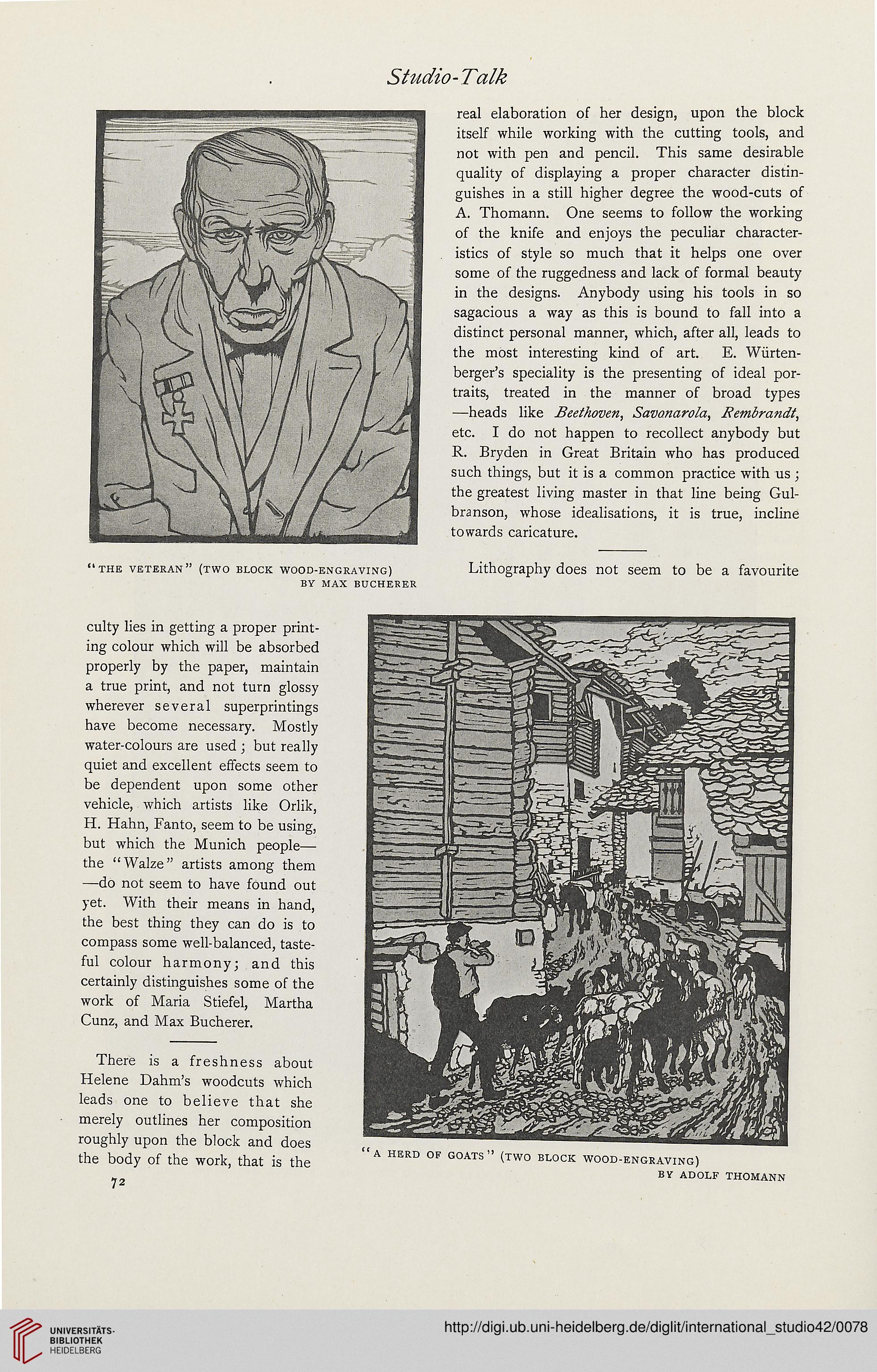Studio-Talk
"the veteran" (two block wood-engraving)
by max bucherer
real elaboration of her design, upon the block
itself while working with the cutting tools, and
not with pen and pencil. This same desirable
quality of displaying a proper character distin-
guishes in a still higher degree the wood-cuts of
A. Thomann. One seems to follow the working
of the knife and enjoys the peculiar character-
istics of style so much that it helps one over
some of the ruggedness and lack of formal beauty
in the designs. Anybody using his tools in so
sagacious a way as this is bound to fall into a
distinct personal manner, which, after all, leads to
the most interesting kind of art. E. Wiirten-
berger's speciality is the presenting of ideal por-
traits, treated in the manner of broad types
—heads like Beethoven, Savonarola, Rembrandt,
etc. I do not happen to recollect anybody but
R. Bryden in Great Britain who has produced
such things, but it is a common practice with us ;
the greatest living master in that line being Gul-
branson, whose idealisations, it is true, incline
towards caricature.
Lithography does not seem to be a favourite
culty lies in getting a proper print-
ing colour which will be absorbed
properly by the paper, maintain
a true print, and not turn glossy
wherever several superprintings
have become necessary. Mostly
water-colours are used ; but really
quiet and excellent effects seem to
be dependent upon some other
vehicle, which artists like Orlik,
H. Hahn, Fanto, seem to be using,
but which the Munich people—
the "Walze" artists among them
—do not seem to have found out
yet. With their means in hand,
the best thing they can do is to
compass some well-balanced, taste-
ful colour harmony; and this
certainly distinguishes some of the
work of Maria Stiefel, Martha
Cunz, and Max Bucherer.
There is a freshness about
Helene Dahm's woodcuts which
leads one to believe that she
merely outlines her composition
roughly upon the block and does
the body of the work, that is the "a herd °f g0ats" (tw0 bl0ck wood-engraving)
72
by adolf thomann
"the veteran" (two block wood-engraving)
by max bucherer
real elaboration of her design, upon the block
itself while working with the cutting tools, and
not with pen and pencil. This same desirable
quality of displaying a proper character distin-
guishes in a still higher degree the wood-cuts of
A. Thomann. One seems to follow the working
of the knife and enjoys the peculiar character-
istics of style so much that it helps one over
some of the ruggedness and lack of formal beauty
in the designs. Anybody using his tools in so
sagacious a way as this is bound to fall into a
distinct personal manner, which, after all, leads to
the most interesting kind of art. E. Wiirten-
berger's speciality is the presenting of ideal por-
traits, treated in the manner of broad types
—heads like Beethoven, Savonarola, Rembrandt,
etc. I do not happen to recollect anybody but
R. Bryden in Great Britain who has produced
such things, but it is a common practice with us ;
the greatest living master in that line being Gul-
branson, whose idealisations, it is true, incline
towards caricature.
Lithography does not seem to be a favourite
culty lies in getting a proper print-
ing colour which will be absorbed
properly by the paper, maintain
a true print, and not turn glossy
wherever several superprintings
have become necessary. Mostly
water-colours are used ; but really
quiet and excellent effects seem to
be dependent upon some other
vehicle, which artists like Orlik,
H. Hahn, Fanto, seem to be using,
but which the Munich people—
the "Walze" artists among them
—do not seem to have found out
yet. With their means in hand,
the best thing they can do is to
compass some well-balanced, taste-
ful colour harmony; and this
certainly distinguishes some of the
work of Maria Stiefel, Martha
Cunz, and Max Bucherer.
There is a freshness about
Helene Dahm's woodcuts which
leads one to believe that she
merely outlines her composition
roughly upon the block and does
the body of the work, that is the "a herd °f g0ats" (tw0 bl0ck wood-engraving)
72
by adolf thomann




